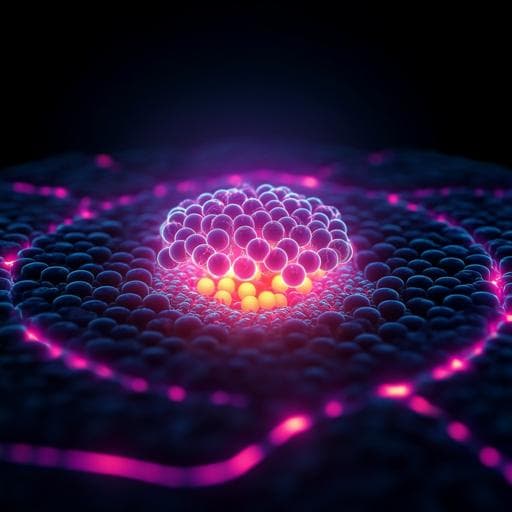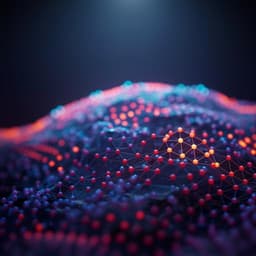
Engineering and Technology
On-chip ultrasensitive and rapid hydrogen sensing based on plasmon-induced hot electron-molecule interaction
L. Wen, Z. Sun, et al.
This innovative study unveils an advanced on-chip plasmonic-catalytic hydrogen sensing technology with an impressive detection limit of just 1 ppm. Conducted by Long Wen and colleagues, this research highlights significant improvements in sensitivity and response time, paving the way for the future of optical gas sensors.
~3 min • Beginner • English
Introduction
Hydrogen is a promising zero-carbon energy carrier with high specific energy but poses safety risks due to low ignition energy, wide flammability range, low density, and high diffusivity. Reliable, rapid, and selective leak detection is therefore critical across production, storage, transportation, and end-use. Conventional selective hydrogen sensors often exploit catalytic interactions with noble metals (e.g., Pd, Pt) and transduce changes in electrical properties (resistance, work function, temperature, refractive index) or optical signals. However, many electrical sensors require elevated temperatures and applied bias, increasing system complexity, power consumption, and explosion risk. Optical methods such as fiber sensors and TDLAS demand complex, bulky, and expensive instrumentation. The field seeks hydrogen sensors meeting the “3A” criteria: Accessible, Affordable, and Applicable. Plasmonic sensing offers strong light–matter interactions and low-cost nanofabrication with high sensitivity, but typically depends on external optical readout instruments. On-chip plasmonic metal–semiconductor nanojunctions have recently enabled direct electric readout via plasmon-enhanced hot-carrier photodetection, yet gas sensing remains challenging due to weak gas–SPR coupling. This work proposes a plasmonic-catalytic MIS nanojunction platform that integrates plasmonic sensing, photoelectric detection, and photocatalysis to enhance hydrogen interaction via hot-electron–molecule processes, enabling ultrasensitive, rapid, room-temperature, zero-bias hydrogen detection.
Literature Review
The paper reviews hydrogen detection approaches: electrical sensors (thermal conductivity, resistance-based, electrochemical, semiconductor junctions) often require high operating temperatures and bias, complicating systems and increasing risks. Optical approaches (fiber sensors, TDLAS) achieve high performance but require spectrometers, tunable lasers, and bulky gas cells with complex demultiplexing. Plasmonic sensors provide ultrahigh sensitivity via strong localized fields and support low-cost fabrication (e.g., nanoimprint, nanosphere lithography, chemical synthesis) but typically rely on external optical instrumentation (spectrometers, specialized systems) due to lack of in situ photoelectric conversion. Prior on-chip direct-electric-readout plasmonic sensors using metal–semiconductor nanojunctions demonstrate hot-electron collection and potential for portable sensing, but direct gas sensing is limited by weak gas–SPR interaction. The present work addresses this gap by leveraging catalytic metal (Pt) to facilitate hydrogen adsorption/dissociation and interfacial dipole formation that modulates hot-electron ejection across an MIS barrier.
Methodology
Device architecture: A plasmonic-catalytic MIS junction comprising a thin Pt film atop an n-type Si substrate patterned with a one-dimensional surface-relief grating. Pt acts as the catalytic layer and Schottky anode; a rear Al–Si contact forms an Ohmic cathode. An ultrathin native/intermediate oxide at the Pt–Si interface creates an MIS barrier to suppress leakage and enhance interfacial sensitivity. The device is majority-carrier collecting hot electrons (Pt/n-Si alignment favors electron ejection). Materials and geometry: Pt thickness nominally ~50–56 nm; n-type Si resistivity 1–10 Ω·cm; grating period P = 1000 nm, ridge width W = 620 nm, depth H = 70 nm; Pt thickness t ≈ 56 nm (from optical fitting/SEM). Fabrication produced conformal Pt over the Si grating. Optical characterization: Zero-order reflectance measured under normal incidence; numerical fitting indicates high-contrast plasmonic resonance with peak absorption approaching ~90%. Optical field/absorption simulations show strong absorption localization in Pt relative to Si. Operating wavelength and coupling: Experiments conducted near the plasmonic resonance at λ = 1064 nm with a slight incident tilt (≈3°) to optimize coupling; angle-dependent photocurrent characterized. Electrical and photoelectric measurements: Photocurrent responsivity measured versus incidence angle under Vb = −1 V to characterize hot-electron collection, yielding peak Rph. Sensing operation performed at room temperature and zero external bias (Vb = 0 V). Time-resolved photoresponses recorded under periodic light on/off in different ambient gases. I–V measurements (dark and illuminated) performed in air and in hydrogen/air mixtures (e.g., 3% H2 in air), revealing hydrogen-tailored photoelectric behavior. Gas interaction mechanism: Hydrogen molecules adsorb and dissociate on Pt; atomic hydrogen diffuses and accumulates near the metal–oxide interface, forming a polarized interfacial dipole layer that modifies band alignment, built-in potential, and tunneling barrier for hot-electron ejection. Modeling and simulation: A quantum tunneling model incorporating a hydrogen-induced interfacial dipole charge layer was developed to predict its effect on hot-electron transmission and photocurrent. TCAD simulations provided energy band diagrams, electric field and potential distributions across the MIS in air vs hydrogen states, elucidating dipole-induced field/potential changes and tunneling conditions. Experimental setup details and supplementary analyses (e.g., distinguishing plasmonic hot-electron signal from Si photovoltaic contribution, angle-coupling optimization) are provided in the supplementary notes referenced in the text.
Key Findings
- Demonstrated an on-chip plasmonic-catalytic MIS nanojunction hydrogen sensor operating at room temperature and zero bias with a detection limit down to 1 ppm. - Achieved sensing signal enhancement by approximately three orders of magnitude and about one order of magnitude faster response compared to non-plasmonic MIS sensors. - Strong plasmonic resonance with simulated peak absorption near 90% in Pt; optical absorption is highly localized in the metal, enabling efficient hot-electron generation. - Angle-dependent photocurrent responsivity exhibits a clear resonance; peak responsivity Rph ≈ 9.4 mA W−1 at λ = 1064 nm (Vb = −1 V), corresponding to EQE ≈ 1.1%. The underlying Si photovoltaic contribution is minor (EQE ≈ 0.02%, R ≈ 0.19 mA W−1), confirming hot-electron-dominated photoresponse. - Time-resolved measurements at zero bias show rapid light-on/off responses in both air and H2/air environments, with substantially reduced photocurrent under H2 exposure (e.g., 3% H2 in air), indicating hydrogen-sensitive modulation of interfacial hot-electron transfer. - I–V characteristics: In air, conventional photodiode-like shift into the fourth quadrant under illumination; in H2, a distinctive S-shaped illuminated I–V with a pronounced current kink at small biases, enabling large signal changes relative to dark operation. - Mechanism: Hydrogen adsorption/dissociation on Pt and subsequent accumulation at the Pt–oxide interface form a polarized interfacial dipole layer. This modifies the MIS band alignment and tunneling barrier, suppressing hot-electron ejection and thereby photocurrent. - The quantum tunneling model including a dipole layer, supported by TCAD band/field/potential profiles, quantitatively reproduces the observed gas-dependent photoelectric behavior, showing strong agreement between theory and experiments.
Discussion
The study addresses the challenge of creating compact, low-power, high-sensitivity hydrogen sensors that meet the 3A criteria by integrating plasmonic light concentration, catalytic surface chemistry, and direct photoelectric transduction in a single MIS nanojunction. Plasmon-induced hot electrons couple strongly to hydrogen through catalytic dissociation and interfacial accumulation, producing a hydrogen-induced dipole that modulates the hot-electron tunneling barrier. This coupling yields a sensitive electrical signature (suppressed photocurrent and an S-kink in illuminated I–V) at room temperature and zero bias, minimizing power and explosion risk while enabling on-chip operation. The measurable difference between air and hydrogen states, the observed resonant enhancement, and the modeling agreement establish that interfacial dipole formation is the dominant mechanism. The results demonstrate that leveraging hot-carrier physics can amplify gas–surface interactions to overcome the weak direct gas–SPR coupling that limits traditional plasmonic gas sensing. The significant sensitivity and response-speed improvements over non-plasmonic MIS sensors highlight the importance of plasmonic absorption localization and tailored nanojunction barriers. These findings are relevant for the development of portable, integrated hydrogen sensors and potentially extendable to other catalytic gases by choosing appropriate metals and interface engineering.
Conclusion
The paper introduces a plasmonic-catalytic MIS nanojunction platform for ultrasensitive, rapid hydrogen detection at room temperature and zero bias. By combining strong plasmonic absorption in Pt with catalytic hydrogen dissociation and an interfacial dipole-modulated tunneling barrier, the device achieves a detection limit down to 1 ppm, three orders of magnitude enhancement in sensing signal, and an order-of-magnitude faster response compared to non-plasmonic counterparts. Distinctive hydrogen-tailored photoelectric features, including a pronounced S-shaped illuminated I–V, are explained by a quantum tunneling model that matches experimental data. This work demonstrates a viable path toward compact, accessible, and affordable on-chip hydrogen sensors and suggests broader applicability to other gas species via materials/interface design. Future research may optimize nanostructure geometries for stronger field localization, engineer interface chemistry for selectivity and stability, and integrate arrays with CMOS electronics for mass-produced portable sensing systems.
Limitations
Related Publications
Explore these studies to deepen your understanding of the subject.







